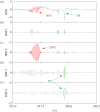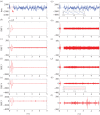Detecting and characterizing high-frequency oscillations in epilepsy: a case study of big data analysis
- PMID: 28280577
- PMCID: PMC5319343
- DOI: 10.1098/rsos.160741
Detecting and characterizing high-frequency oscillations in epilepsy: a case study of big data analysis
Abstract
We develop a framework to uncover and analyse dynamical anomalies from massive, nonlinear and non-stationary time series data. The framework consists of three steps: preprocessing of massive datasets to eliminate erroneous data segments, application of the empirical mode decomposition and Hilbert transform paradigm to obtain the fundamental components embedded in the time series at distinct time scales, and statistical/scaling analysis of the components. As a case study, we apply our framework to detecting and characterizing high-frequency oscillations (HFOs) from a big database of rat electroencephalogram recordings. We find a striking phenomenon: HFOs exhibit on-off intermittency that can be quantified by algebraic scaling laws. Our framework can be generalized to big data-related problems in other fields such as large-scale sensor data and seismic data analysis.
Keywords: big data analysis; electroencephalogram; empirical modedecomposition; epileptic seizures; high-frequency oscillations; nonlinear dynamics.
Figures











Similar articles
-
Mathematical structures for epilepsy: High-frequency oscillation and interictal epileptic slow (red slow).Neurosci Res. 2020 Jul;156:178-187. doi: 10.1016/j.neures.2019.11.008. Epub 2019 Nov 20. Neurosci Res. 2020. PMID: 31758974
-
Dynamic changes of ictal high-frequency oscillations in neocortical epilepsy: using multiple band frequency analysis.Epilepsia. 2007 Feb;48(2):286-96. doi: 10.1111/j.1528-1167.2007.00923.x. Epilepsia. 2007. PMID: 17295622
-
Detecting position dependent tremor with the Empirical mode decomposition.J Clin Mov Disord. 2015 Feb 16;2:3. doi: 10.1186/s40734-014-0014-z. eCollection 2015. J Clin Mov Disord. 2015. PMID: 26788339 Free PMC article.
-
Update on the mechanisms and roles of high-frequency oscillations in seizures and epileptic disorders.Epilepsia. 2017 Aug;58(8):1330-1339. doi: 10.1111/epi.13830. Epub 2017 Jul 6. Epilepsia. 2017. PMID: 28681378 Free PMC article. Review.
-
Epileptic High-frequency Oscillations in Scalp Electroencephalography.Acta Med Okayama. 2018 Aug;72(4):325-329. doi: 10.18926/AMO/56166. Acta Med Okayama. 2018. PMID: 30140078 Review.
Cited by
-
Generalizability of High Frequency Oscillation Evaluations in the Ripple Band.Front Neurol. 2018 Jun 28;9:510. doi: 10.3389/fneur.2018.00510. eCollection 2018. Front Neurol. 2018. PMID: 30002645 Free PMC article.
-
Noise-Assisted Multivariate EMD-Based Mean-Phase Coherence Analysis to Evaluate Phase-Synchrony Dynamics in Epilepsy Patients.IEEE Trans Neural Syst Rehabil Eng. 2018 Dec;26(12):2270-2279. doi: 10.1109/TNSRE.2018.2881606. Epub 2018 Nov 15. IEEE Trans Neural Syst Rehabil Eng. 2018. PMID: 30452374 Free PMC article.
-
Survival and weak chaos.R Soc Open Sci. 2018 May 16;5(5):172181. doi: 10.1098/rsos.172181. eCollection 2018 May. R Soc Open Sci. 2018. PMID: 29892407 Free PMC article.
-
Progress and Remaining Challenges in the Application of High Frequency Oscillations as Biomarkers of Epileptic Brain.Curr Opin Biomed Eng. 2017 Dec;4:87-96. doi: 10.1016/j.cobme.2017.09.006. Epub 2017 Sep 22. Curr Opin Biomed Eng. 2017. PMID: 29532041 Free PMC article.
References
-
- Marx V. 2013. Biology: the big challenges of big data. Nature (London) 498, 255–260. (doi:10.1038/498255a) - DOI - PubMed
-
- Sagiroglu S, Sinanc D. 2013. Big data: a review. In 2013 Int. Conf. on Collaboration Technologies and Systems (CTS), San Diego, CA, pp. 42–47. IEEE.
-
- Katal A, Wazid M, Goudar RH. 2013. Big data: issues, challenges, tools and good practices. In Sixth Int. Conf. on Contemporary Computing (IC3), Noida, pp. 404–409. IEEE.
-
- Chen M, Mao SW, Zhang Y, Leung VCM. 2014. Big data related technologies, challenges and future prospects. Berlin, Germany: Springer.
-
- Fan JQ, Han F, Liu H. 2014. Challenges of big data analysis. Nat. Sci. Rev. 1, 293–314. (doi:10.1093/nsr/nwt032) - DOI - PMC - PubMed
Grants and funding
LinkOut - more resources
Full Text Sources
Other Literature Sources
Research Materials

